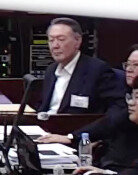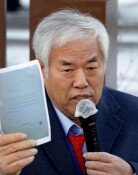Baekundongcheon restoration will bring back beauty of Seoul
Baekundongcheon restoration will bring back beauty of Seoul
Posted June. 19, 2023 07:57,
Updated June. 19, 2023 07:57
Mountains boast of their firmness and water streams flow down. Once this summer monsoon fades away, flowing valley water will run in abundance around the town of Suseong-dong, as its name implies, against the rocky walls of Mt. Inwang dubbed the White Tiger of Seoul’s West from the perspective of Feng Shi or Chinese geomancy. You may find nature-loving readers sitting tightly between rocks in the upstream of the valley feeling chilly even in the middle of a summer day under the cloudless skies. Strolling downstream, you happen to see an adorable toddler who has just started walking, enjoying his first fun excursion in a valley while splashing in the knee-deep water. Kids may spend the whole day catching tadpoles playfully, their shorts unknowingly wet. It was a lucky experience for me to live in this neighborhood for some years with my young children.
Suseong-dong is described in Gyeomjae Jeong Seon’s “Album of Eight Scenic Sites of Jang-dong in Seoul,” a work of art that portrays mesmerizing sceneries around the Jang-dong area ranging from the southern foot of Mt. Inwang to Baegak (Bukak) Valley. This painting shows scholars and a young boy who have just crossed a small stone bridge (Giringyo), which had been believed to be destroyed entirely with Okin apartment buildings under construction during the 1960s but was discovered out of nowhere around 2009. The truth is Giringyo has always been there for a long period but only faded from our memories.
Once indifference sets in, you fail to see whatever is right next to you. Since the modern era began, the memories of water have faded into oblivion in the capital of Seoul. Although overseas visitors today are said to be surprised by the mountains around the capital city, not only the mountains but also the water was the reason why Hanyang, the old name of Seoul, was chosen as the capital city of the Joseon Dynasty. Maps dating back to the Joseon era describe the castle town of Hanyang covered with a web of waterways. There must have been countless small bridges built around it. With domestic sewage joining into the stream, the quality of water must not have been kept so high. Nevertheless, the embankments of the waterways were presumably decorated with blossoming flowers, and residents might have enjoyed the fun of crossing charmingly-seated bridges. The Han River has been too big to be forgotten, but almost none of the small streams of water has remained in our memories.
Baekundongcheon Stream is also part of the “Album of Eight Scenic Sites of Jang-dong in Seoul.” Known as the longest water source of Cheonggye Creek, it is deemed the origin of water in the castle town as it flows around Gyeongbokgung Palace. Valley water from Suseong-dong joins Baekundongcheon Stream to flow into Cheonggye Creek. However, only a few remember Baekundongcheon Stream as it was covered in 1925 under Japanese rule. It is only remembered and found in the origin of the name Cheongun-dong, which was derived from Cheongpung Valley and Baekun-dong.
Hearing that the old site of Baekunjang - where Baekundongcheon Stream starts and Dongnong Kim Ga-jin, the head of a secret independent organization called Daedong Dan, resided working for the country's independence – will be sold, I made time for a visit. I came across bushy wild berries all over the area. Despite being located on the way to Mt. Inwang and Mt. Bukak, the privately owned property looked almost intact.
Baekundongcheon Stream and other waterways in Seoul have been renovated to build car roads since modern times. As the newly built infrastructure has contributed greatly to the capital city's development, it deserves to be celebrated as well. However, equally importantly, we need to look back on what's forgotten and dream of adding a new layer to the urban area. It is reported that the Seoul Metropolitan Government is working to study how to recover the waterways of the Baekundongcheon Stream and Junghak Stream (Samcheongdongcheon Stream). If its efforts turn out successfully, Cheonggye Creek will partly gain value as a spontaneously created stream. Some propose to build a park for ecology and history by associating the origin of the Baekundongcheon Stream and the historical values of Baekunjang. Hopefully, the beauty of Seoul will be appreciated more highly if it incredibly restores the harmony of mountains and waterways.







